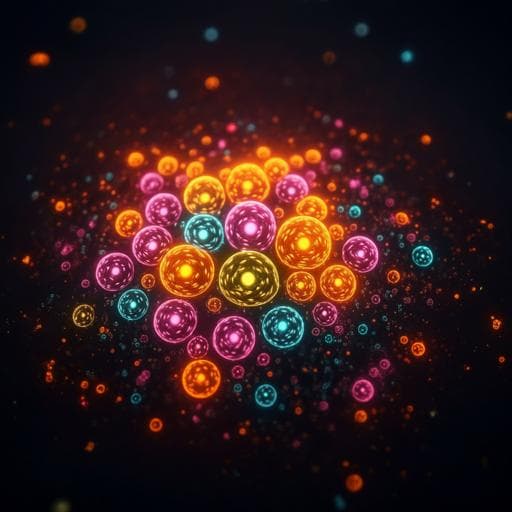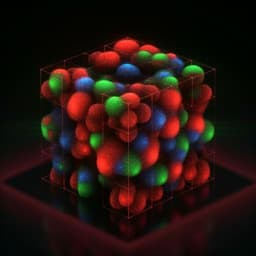
Chemistry
Photo-triggered full-color circularly polarized luminescence based on photonic capsules for multilevel information encryption
S. Lin, Y. Tang, et al.
Discover groundbreaking device-friendly solid films with remarkable color tunability, crafted through Förster resonance energy transfer (FRET) within liquid crystal photonic capsules. These innovative capsules boast photoswitchable circularly polarized luminescence, enabling multilevel data encryption—research conducted by Siyang Lin, Yuqi Tang, Wenxin Kang, Hari Krishna Bisoyi, Jinbao Guo, and Quan Li.
~3 min • Beginner • English
Introduction
The study addresses the need for advanced, high-security information encryption materials that go beyond conventional fluorescence-based or time-responsive afterglow strategies. Circularly polarized luminescence (CPL) adds an additional information dimension (polarization state) for encryption. Cholesteric liquid crystals (CLCs), with self-organized helical superstructures and stimuli-responsiveness, are promising CPL-active platforms but practical deployment is limited by the lack of materials combining multiple responses, precise local tuning, high glum, and facile processing. The authors propose constructing phototunable CPL systems using liquid crystal photonic capsules (LCPCs) that integrate chiral donors and photoswitchable achiral acceptors to produce full-color, time-dependent CPL suitable for multilevel (2D/3D/4D) information encryption.
Literature Review
Prior work has explored fluorescence-switchable and time-responsive afterglow materials to extend QR codes into 3D codes, and CPL-active systems for covert information encoding and authentication. CLC-based systems can generate tunable CPL with large dissymmetry factors due to their helical architectures and responsiveness. Reports include wavelength-controllable CPL laser arrays for dual-dimensional encryption and photochemical dual-responsive CPL materials encoding wavelength, intensity, and chirality. However, comprehensive multilevel encryption based on CLC-derived CPL materials has been scarce, with challenges in achieving multiple responses, local tuning, high glum, and easy operation. This work builds on dynamic FRET in chiral nematic media, prior CPL amplification and switching in CLCs, and phototunable full-color emission systems, aiming to deliver device-friendly, full-color, time-resolved CPL platforms for encryption.
Methodology
- Molecular design and synthesis: A chiral fluorescent donor (S)-CNB (and (R)-CNB for comparison) and achiral diarylethene molecular switches DG and DR (acceptors) were synthesized and characterized by 1H/13C/19F NMR and HR-MS. Chiral induction ability of (S)-CNB was quantified by the Grandjean-Cano method; helical twisting power (HTP) in 5CB was 11.43 µm−1.
- Photophysics and switching: (S)-CNB in 5CB emits at 436 nm with 32.46% quantum yield and strong right-handed CPL (glum ≈ −0.33), while (R)-CNB shows opposite CPL (glum up to +0.38). DG and DR undergo reversible photocyclization/cycloreversion (UV/visible). Photostationary states were analyzed by NMR: DG in PSS365 yields open:closed ≈ 12%:88% with ~100% cycloreversion under 450 nm; DR photocyclization is ~100% to closed form, but cycloreversion under 500 nm reaches only 18.8% after 10 h.
- FRET platform construction in CLCs: Binary (CNB/DG; LC-D) and ternary (CNB/DG/DR; LC-T) FRET systems were prepared in 5CB nematic host (helical superstructures induced by CNB). Spectral overlap between donor emission and acceptor (closed-isomer) absorption enables UV-driven FRET. Stepwise FRET in LC-T employs closed-DG as an intermediate bridge from CNB to closed-DR.
- Device preparation: To enable solid-state, processable films, luminescent CLCs were encapsulated into microcapsules via interfacial polymerization using isophorone diisocyanate (IPDI) in dichloromethane (core:shell 4:1) dispersed in 2 wt% PVA aqueous phase, catalyzed by DBTDL at 80 °C for 6 h. Capsules (10–15 µm diameter; ~500 nm polymer shell) were dispersed in 8 wt% PVA and spin- or bar-coated to fabricate LCPC films on glass or PET.
- Sample compositions: LC systems included (S)-LC-D (3.0 wt% (S)-CNB, 1.5 wt% DG, 95.5 wt% 5CB) and (S)-LC-T (3.0 wt% (S)-CNB, 1.5 wt% DG, 1.0 wt% DR, 94.5 wt% 5CB). LCPC variants: LCPC-S (CNB only), LCPC-D (CNB/DG), LCPC-T (CNB/DG/DR), and blends (e.g., S/D, D/T, S/T, S/D/T).
- Spectroscopy and imaging: Fluorescence (Hitachi F-4500), CD (JASCO 810), CPL and glum (JASCO CPL-200), lifetimes via TC-SPC (FLS980), quantum yields and CIE coordinates (FLS980). SEM for morphology and shell thickness. POM for textures and phase transitions. Time-dependent PL under 365 nm UV (1.0 mW/cm²) recorded to map intensity evolution.
- Kinetic and efficiency analysis: FRET efficiency E = 1 − τAD/τD from donor lifetimes. Lifetime decays fitted bi-exponentially; average lifetimes computed accordingly. TD-DFT (Gaussian 09, B3LYP; 6-31G(d) for CNB, Lanl2DZ for DG/DR) estimated S1 energies for FRET feasibility.
- Application demos: Full-color generation by additive mixing of LCPCs; flexible films and direct ink writing patterns; photomask programming; 2D/3D encryption using color and CPL channels; 4D bar code using time-dependent RGB intensity profiles and polarization as keys, with computer verification of I(t) profiles.
Key Findings
- Dynamic FRET and CPL switching:
- In LC-D, UV-driven FRET shifts emission from blue (CNB) to green (closed-DG): PL peak 434→510 nm; CPL shifts accordingly with glum changing from −0.21 to −0.10 ((S)-system). (R)-LC-D shows mirror-sign CPL (+0.17→+0.14).
- In LC-T, stepwise FRET (CNB→closed-DG→closed-DR) yields red emission (~600 nm) with CPL; initial blue CPL is fully quenched under UV. glum in PSS365: −0.15 for (S)-LC-T and +0.21 for (R)-LC-T.
- FRET efficiencies from lifetimes:
- (S)-CNB without acceptor: τ ≈ 4.601 ns.
- (S)-LC-D at PSS365: τ(CNB) ≈ 0.860 ns → E ≈ 81.3%.
- (S)-LC-T at PSS365: τ(CNB) ≈ 0.278 ns → E ≈ 94.0%.
- (S)-LC-B/R (CNB+DR only): E ≈ 67.0% (demonstrating necessity of DG bridge).
- Lower-step FRET (closed-DG→closed-DR): DG τ decreases 1.229→0.584 ns; E ≈ 52.5%.
- Switching kinetics and photochemistry:
- DG PSS365 composition: 12% open : 88% closed; near-quantitative cycloreversion at 450 nm.
- DR: 100% photocyclization to closed form; cycloreversion only 18.8% after 10 h at 500 nm.
- LCPC material performance:
- Microcapsules: spherical, 10–15 µm; ~500 nm shell; thermally stable up to 100 °C; reversible cholesteric→isotropic transition (~28 °C for LCPC-D) and back.
- Films (in PVA) show robust time-dependent PL under UV; LCPC-S stable blue; LCPC-D/T evolve to green/red via FRET. PSS365 CPL peaks and glum: LCPC-S 445 nm, −0.11; LCPC-D 535 nm, −0.08; LCPC-T 639 nm, −0.063.
- Reversibility: LCPC-D switches between blue/green for ≥10 cycles (365/450 nm). LCPC-T red→pink under prolonged 500 nm due to partial DR cycloreversion.
- Stability: PSS365 states stable at room temperature for at least one week; intermediate states stable in dark (no thermal relaxation).
- Full-color emission and CPL:
- Additive mixing of LCPC-S/D/T yields cyan, yellow, purple, and near-white; S/D/T blend at PSS365 has CIE (x,y)≈(0.301, 0.319).
- Full-color CPL observed across blends with glum between −0.063 and −0.11.
- Flexible PET films and direct ink writing demonstrate processability; masked UV enables programmed patterns.
- Encryption demonstrations:
- 2D encryption: UV (key 1) reveals color; color-based rearrangement (key 2) deciphers hidden word “FRET.”
- 3D encryption: Array combining PL-only (LCPC-G/R) and PL+CPL (LCPC-D/T) yields visible decoy “BLUE” in PL, and hidden “LC” in CPL; chirality amplification with left-handed CLC reflective films increases apparent glum to −1.58 (LCPC-S), −1.72 (LCPC-D), and +1.39 (LCPC-T).
- 4D bar code: Uses color channel number, irradiation time, and polarization state as cipher. Time-resolved RGB intensity ratios B/G and B/T at specified t (e.g., 30 s, 90 s) authenticate bars against stored I–t profiles, with CPL detection removing fluorescent camouflage to recover true code (e.g., “CPL”).
Discussion
The work demonstrates that embedding dynamic FRET systems within chiral CLC helical superstructures, and further encapsulating them into photonic microcapsules, yields solid films with phototunable, full-color CPL and strong time dependence. Energy transfer from a chiral donor (CNB) to photoactivated achiral acceptors (DG, DR) enables both wavelength and chirality transfer, producing RGB CPL with large and sign-controllable glum depending on donor handedness. The stepwise FRET architecture markedly enhances transfer efficiency (up to 94%) and enables red CPL emission. Encapsulation renders the system device-friendly, flexible, and prevents inter-capsule energy leakage, allowing additive color mixing to achieve full-color PL and CPL including near-white. The time stability of intermediate photostates and tunable response kinetics permit encoding information in multiple dimensions—spectral color, polarization state, and time—supporting 2D, 3D, and 4D encryption schemes. The significant amplification of chiral signals using CLC reflective films further enables naked-eye CPL decoding. Collectively, these results address the challenge of practical, high-security CPL-based encryption media by integrating multiresponsive behavior, local programmability, and processability.
Conclusion
The study introduces LC photonic capsules that deliver phototunable full-color CPL via dynamic FRET between a chiral donor and photochromic achiral acceptors confined in CLC helices. Solid films and flexible devices exhibit RGB CPL with time-resolved behavior, reversible switching, and additive full-color mixing, enabling multilevel (2D/3D/4D) information encryption. Measured FRET efficiencies reach 94% with stepwise transfer, and CPL dissymmetry can be substantially amplified with CLC reflective films for straightforward decryption. These LCPCs integrate fluorescence, time response, full-color, and CPL characteristics, offering a promising platform for advanced secure data storage and photonic applications. Future work may focus on improving capsule alignment to enhance glum, accelerating acceptor cycloreversion for faster color reset, minimizing UV requirements, and integrating with scalable printing and readout systems.
Limitations
- Reduced CPL dissymmetry in LCPCs compared to LC cells due to imperfect planar orientation of helical superstructures inside spherical microcapsules.
- DR shows very low cycloreversion efficiency (only ~18.8% after 10 h at 500 nm), slowing red-to-blue/green reset and limiting rapid rewritability.
- Partial unintended DR photocyclization can occur under UV excitation during measurements, complicating initial-state CPL baselines.
- Operation relies on UV irradiation for switching, which may pose material compatibility and safety considerations for some applications.
- Although intermediate states are stable in the dark, long-term stability beyond one week and under varied environmental conditions was not detailed.
- The demonstrated high glum amplification requires additional CLC reflective films, adding system complexity.
Related Publications
Explore these studies to deepen your understanding of the subject.







